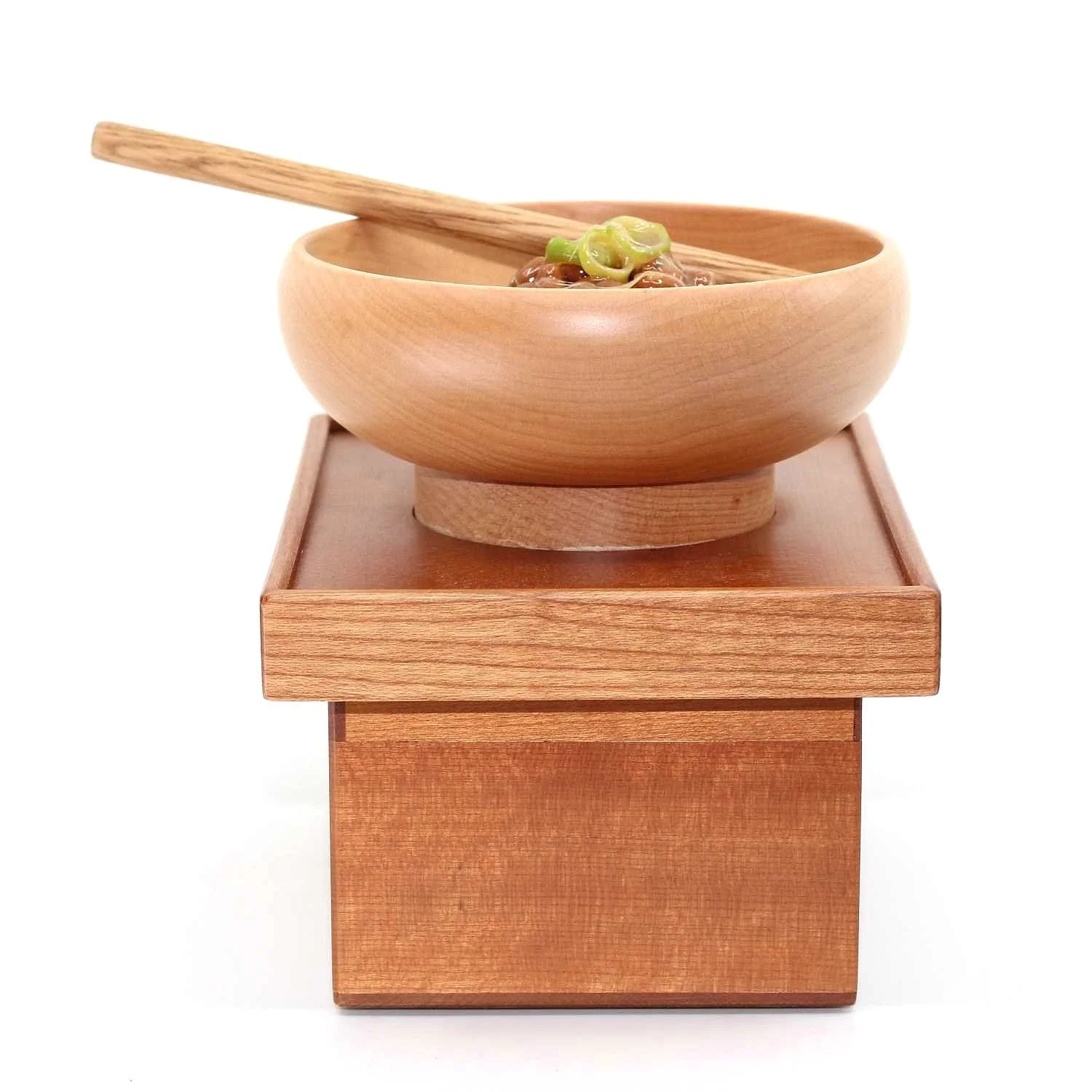Playing With Your Food
This is Natto
This is Natto by Yasuaki Kikuchi
The traditional dish of fermented soybeans, known as natto, has been a staple of Japanese diet for millennia. The rich source of vitamins, minerals and protein is typically eaten cold, over rice, with some mustard, soy or onions on top. Stirring it produces sticky stringy strands that adhere between the beans. Many say it is an acquired taste, like a pungent cheese, but a majority of Japanese people like it.
Thus it was that Karakuri Creation Group puzzle box artist Yasuaki Kikuchi decided to reproduce this iconic dish for their Japan themed exhibit a few years ago. “The theme was "Japanese," so I wanted to make natto, a favorite Japanese food. Natto has a special way of stirring many times before eating, so I thought it would be interesting to incorporate that movement into the Karakuri box.
firm ent ertainment
In addition, Japan has a culture of food samples, and they have the know-how to make food that looks like the real thing using wax and resin. I thought that if I placed samples that looked like natto in a wooden container, I could create a Karakuri box that only Japanese people could make.” Kikuchi has indeed done that, and the result is highly convincing. Although there are many food themed Karakuri boxes that exist, none may be as realistic as Natto.
“The natto in this work was made by hand, one by one, by rolling clay and coating it with resin. It was very difficult, but also fun. The mechanism was that the drawer would not open unless it was [activated in a certain way], and I used [properties of physics and hidden materials], but even though the prototype worked well, it was very difficult to make multiple pieces that would give the same results.” The box is rather tricky to open, and can be finicky, but with patience and persistence it will work every time. It definitely requires a cool trick that aligns with the theme perfectly. In fact, Kikuchi intended it to be slightly finicky, and require patience and persistence.
this is nattopen yet
“Finally, I would like to explain the Japanese name of this work. I made this as a twist on the old proverb, "If you don't persist, you won't get emptiness." In Japanese, the word "sticky" has two meanings. The first refers to the sticky texture of natto. The second describes a person working hard at something without giving up. Next, the word "emptiness" also has two meanings. One is that the Karakuri Box will eventually open up somewhere, creating space. The other is that it is an important concept in Buddhism, but it is a word related to impermanence and relativity, and is difficult to explain, so I will not go into detail here.” Kikuchi is the philosopher of the Karakuri group, and his work often has a much deeper meaning embedded into the story behind the object.
let me shoyu
“This has gotten long, but my main goal was to reflect the concepts mentioned above in the way this Karakuri Box is opened. But in the end, it goes without saying that it is my own Karakuri Box making that I will need to work harder and more persistently in the future – haha!” Yasuaki has developed a fan following thanks to his hard work and creative, clever and beautiful work, which is highly regarded and eagerly anticipated. This is Natto won the Karakuri group’s Best Box of the Year award in 2020.
Natto Bamboo
A cocktail toast to compliment a dish of cold natto should naturally have flavors that blend well and reference the dish. Which might suggest, in this case, that we add a little soy sauce to the mix. Crazy? Not really. Cocktail flavors can be augmented with salt and umami just like with any recipe. In fact, Kikkoman, the famous soy sauce brand, even has a recipe for a “Soy Martinez” on their website. The Martinez was the original Martini, that classic with gin and dry vermouth. The Martinez, which predates the Martini, featured gin and sweet vermouth, and historically also included a sweet liqueur like cherry or orange. Kikkoman’s Soy Martinez is historically accurate, with a fifty fifty ratio of gin and sweet vermouth, plus a little cherry liqueur, and the signature addition of their naturally brewed soy sauce.
Me Ol’ Bam-Boo
For the natto toast I took inspiration from the Soy Martinez but leaned instead on a classic sherry cocktail with Japanese roots, the Bamboo. The original, featuring dry sherry and dry vermouth, is attributed to San Francisco bartender Louis Eppinger, who was recruited to manage the bar at the new Grand Hotel in Yokahama in 1899. Simon Difford, the English spirits writer, suggests a “perfect” version of the Bamboo using dry, blanco, and rosso vermouth to compliment the dry sherry, along with a dash of orange bitters. I borrowed elements from this version, and completed the tribute with a light shoyu (Japanese soy sauce). Finally I substituted Japanese yuzu bitters to tie it all together, which lends the perfect citrus element. It may well be the best Bamboo yet, but regardless of comparisons, it’s delicious! Kampai!
a tasty pair
Natto Bamboo
1 ½ oz fino sherry
¾ oz dry vermouth
¾ oz Cocchi Rosa
¼ oz white shoyu
Dash yuzu bitters
Sitr ingredients with ice and strain into a cocktail glass. Lemon twist.
explore more:







